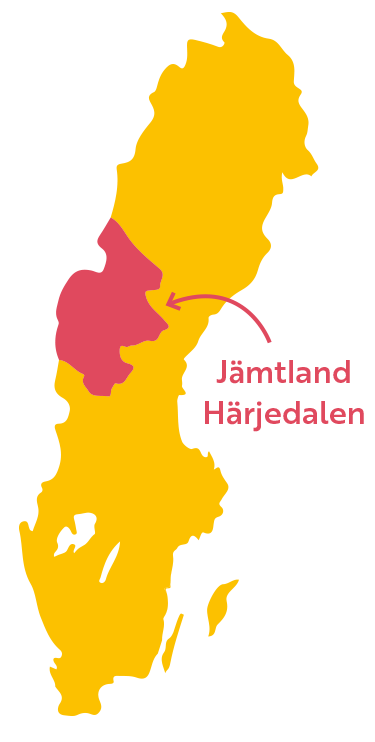Move to Sweden
Thinking of moving to Sweden? A northern land of verdant summers and snowy winters. Where people get together over ‘fika’, queue politely in shops, and dance around the decked-out Christmas tree at Yule or round the maypole on Midsummer’s Eve, with flowers in their hair. Read on to learn more about Sweden – from key facts to fun trivia – and find out how to move here.
Area: 48,935 km2 (the land area of Jämtland County is larger than Switzerland)
Population: 132 572
Capital: Östersund
Municipalities: Berg, Bräcke, Härjedalen, Krokom, Ragunda, Strömsund, Åre, Östersund

Useful links
Sweden.se – About Sweden: life, work, studies, entrepreneurship, culture and climate
Migrationsverket: to apply for a visa and residence permit
Moving to Jämtland county
Right in the heart of Sweden, along the border with Norway, lies Jämtland-Härjedalen. A region characterised by mountains, forests, lakes and pastures. It is home to just one city. Yes, you’ve read that correctly. But this one city isn’t just any city: it offers everything from locally-produced artisanal delicacies to international research. Östersund is the capital of the large county, which encompasses eight different municipalities, each with their own municipal centre. There are also numerous towns and myriad small villages in the countryside.
Get in touch with an immigration guide by filling in this form. It sets you in contact with the municipalities you’re interested in – they will be happy to answer your questions and offer guidance.

Almost 132,000 locals live in the area, spread out across 48,935 km2. In recent years, increasing numbers of people have moved to Jämtland, drawn to its breathtaking nature. Close to everything you could need and with endless recreational opportunities right outside your front door. With clean air, crystal-clear water and acres of space. Take your pick of any of the region’s exciting sectors to work in. Or why not start your own company?
Swedes love nature and being outdoors. ‘Allemansrätten’ (the Right of Public Access) allows you to freely roam the country, even private land, as long as you do not disturb or destroy anything.

You can learn Swedish through sfi (Swedish for immigrants), a service each municipality is required to offer.

Sweden is a highly digitalised country where a lot of services are available online – you can, for example, contact authorities, book appointments or purchase goods and services online.

The word ‘lagom’ is used all the time, but is difficult to translate. Depending on the context, it may mean something like ‘enough’, ‘just right’ or ‘not too much.’

Sweden is one of the most gender equal countries in the world. Together, parents get no fewer than 480 days of paid parental leave.

Swedes like to meet over a cup of coffee or tea, ideally with a cinnamon bun or two on the side – the fabled ‘fika’.

Step by step
Preparation is key (or ‘A and O’, as we say in Sweden!) to getting off to a flying start in a new country. Below, we’ve included our best tips and a list of websites with information about how to make the move to Sweden. Requirements depend on whether you’re currently living inside or outside of the EU/EEA. The links will provide you with information about your specific situation. Here are five important things you should consider.

1: How will you support yourself – will you be employed or starting a company?
For most people, finding a job is a prerequisite for being able to move to and live in Sweden. You can apply for jobs by yourself or you can register with the Swedish Public Employment Service, which can help you find work.
If you’d like to start your own company, Verksamt.se offers a step-by-step guide on how to do so.
Read more about working in Sweden and growth sectors in the country.
2: Where do you want to live – in a city or in the countryside?
You should find a place to stay before you move to Sweden. Would you prefer a house or a farm in the countryside, or a flat in town? Will you be buying or renting? In Sweden, you can rent from either a municipal housing company or a private landlord. If you’ll be studying, talk to your university: sometimes, they are able to arrange housing for students.

3: Do you need a residence permit?
The Swedish Migration Agency deals with issues relating to immigration, visas, work permits and citizenship.
If you’ve moved to Sweden and plan on staying for a year or more, you’ll need to register as a resident to be listed in the Swedish Population Register. EU/EEA citizens do not need to apply for a permit to work or live in Sweden, and automatically have the right to start a company in the country.
4: Register with the Swedish Tax Agency
Once you’ve arrived, you’ll need to register as a resident in your municipality and apply for a ‘personnummer’, a personal identification number. You’ll need this legal number to prove your identity in daily life, like when you’re opening a bank account or receiving your salary. You can also apply for an ID card at the Swedish Tax Agency. This makes it easier to apply for credit cards, pick up parcels or identify yourself when visiting a doctor. Please note that at the moment this process can take up to six months.

5: Find a (nursery) school for your children
There are different kinds of schools in Sweden. Always start by contacting the municipality you will be living in.
Just a few tips before you make the move:
- Visit the region in different seasons to get to know its climate in advance.
- Definitely start learning Swedish in your home country, for example by taking evening classes or an online course.
- Find out what it’s like to live, study, work and purchase a home in Sweden.
- Contact the municipality you’re interested in – they will be happy to answer your questions and offer guidance.